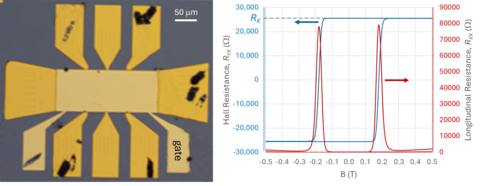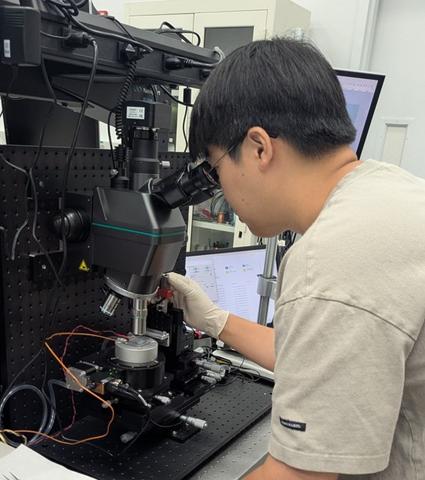Summary
The quantum anomalous Hall effect (QAHE) yields a quantized Hall resistance without the need for an external magnetic field. This effect offers a promising path toward a deployable, unified electrical standards system, potentially allowing the volt, ohm, and ampere to be realized in a single cryostat. However, the QAHE currently requires extremely low (millikelvin) temperatures to achieve accurate quantization. Our goal is to raise the operational temperature of QAHE systems to the 1–2 K range, making them compatible with compact, cryogen-free refrigerators and enabling broader metrological applications.
We study the QAHE in magnetically doped topological insulators and novel two-dimensional materials, such as rhombohedral graphene and twisted MoTe₂ bilayers. To uncover and address the limiting factors of the effect, we utilize low-temperature magneto-transport measurements.
Description

Measuring the quantum value of resistance, the von Klitzing constant, RK, in a quantum anomalous Hall effect device (left). Quantized resistance data (right).
It is necessary to isolate, control, and understand the fundamental physics of exotic states of matter to create nanoengineered systems with the requisite quantum properties for quantum information systems and advanced computing applications. We develop measurement capabilities and design test structures so that the fundamental properties of solid-state quantum systems can be experimentally determined. At the core of this program are cryogenic measurements of novel devices, heterostructures, and the atomically engineered materials that comprise them. Transport measurements are the gold standard for demonstrating and identifying emergent quantum properties such as superconductivity or metal/insulator transitions. This program includes the fabrication of such devices and heterostructures and their electrical and physical characterization. We are currently focused on research that will facilitate the use of topologically protected solid state electronic systems and quantum materials based on.

We perform basic experimental research to extract the fundamental properties of topologically protected solid state electronic systems. The results of these measurements are used to assess if the underlying physics in these systems can be harnessed for quantum applications such as metrology and standards dissemination.

